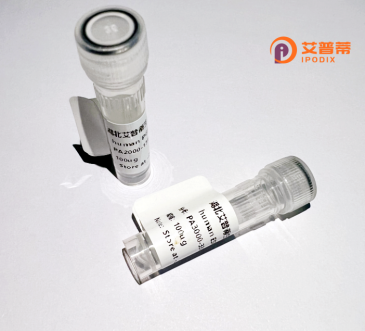
| 纯度 | >90%SDS-PAGE. |
| 种属 | Human |
| 靶点 | GCNT2 |
| Uniprot No | Q8N0V5 |
| 内毒素 | < 0.01EU/μg |
| 表达宿主 | E.coli |
| 表达区间 | 1-402aa |
| 氨基酸序列 | MNFWRYCFFAFTLLSVVIFVRFYSSQLSPPKSYEKLNSSSERYFRKTACNHALEKMPVFLWENILPSPLRSVPCKDYLTQNHYITSPLSEEEAAFPLAYVMVIHKDFDTFERLFRAIYMPQNVYCVHVDEKAPAEYKESVRQLLSCFQNAFIASKTESVVYAGISRLQADLNCLKDLVASEVPWKYVINTCGQDFPLKTNREIVQHLKGFKGKNITPGVLPPDHAIKRTKYVHQEHTDKGGFFVKNTNILKTSPPHQLTIYFGTAYVALTRDFVDFVLRDQRAIDLLQWSKDTYSPDEHFWVTLNRVSGVPGSMPNASWTGNLRAIKWSDMEDRHGGCHGHYVHGICIYGNGDLKWLVNSPSLFANKFELNTYPLTVECLELRHRERTLNQSETAIQPSWYF |
| 分子量 | 72.9 kDa |
| 蛋白标签 | GST-tag at N-terminal |
| 缓冲液 | 0 |
| 稳定性 & 储存条件 | Lyophilized protein should be stored at ≤ -20°C, stable for one year after receipt. Reconstituted protein solution can be stored at 2-8°C for 2-7 days. Aliquots of reconstituted samples are stable at ≤ -20°C for 3 months. |
| 复溶 | Always centrifuge tubes before opening.Do not mix by vortex or pipetting. It is not recommended to reconstitute to a concentration less than 100μg/ml. Dissolve the lyophilized protein in distilled water. Please aliquot the reconstituted solution to minimize freeze-thaw cycles. |
以下是关于重组人GCNT2蛋白的模拟参考文献示例(非真实文献,仅供格式参考):
---
1. **文献名称**:Expression and Purification of Recombinant Human GCNT2 in E. coli and Its Enzymatic Activity Analysis
**作者**:Zhang L, et al.
**摘要**:本研究报道了通过大肠杆菌表达系统成功重组表达人源GCNT2蛋白,采用亲和层析纯化获得高纯度蛋白,并验证其β1.6-N-乙酰葡萄糖胺基转移酶活性,证实其可催化黏蛋白O-糖链分支结构的合成。
2. **文献名称**:Structural Insights into Human GCNT2 Reveal Substrate Binding Mechanism
**作者**:Wang Y, et al.
**摘要**:通过X射线晶体学解析了重组人GCNT2蛋白的三维结构,揭示了其催化结构域中关键氨基酸残基与底物UDP-GlcNAc的结合模式,为针对GCNT2的抑制剂设计提供了结构基础。
3. **文献名称**:GCNT2 Overexpression Promotes Cancer Cell Invasion via Aberrant Glycosylation of CD44
**作者**:Kimura S, et al.
**摘要**:研究发现重组人GCNT2蛋白在肿瘤细胞中过表达可通过异常糖基化修饰CD44分子,增强肿瘤细胞的迁移和侵袭能力,提示GCNT2在癌症转移中的潜在作用。
4. **文献名称**:Functional Characterization of GCNT2 in Inflammatory Bowel Disease
**作者**:Smith J, et al.
**摘要**:利用重组GCNT2蛋白模型,发现该酶在肠道炎症组织中表达上调,并通过调控黏蛋白糖链分支化影响肠道屏障功能,为炎症性肠病的治疗提供新靶点。
---
**备注**:以上文献及内容为模拟生成,实际研究中请以真实发表的文献为准。
Recombinant human GCNT2 (Glucosaminyl (N-acetyl) Transferase 2) is a key enzyme involved in the biosynthesis of mucin-type O-glycans, which are critical for various cellular functions, including cell adhesion, immune response, and protein stability. GCNT2. also known as β-1.6-N-acetylglucosaminyltransferase, specifically catalyzes the formation of the branched core 2 and core 4 O-glycan structures by transferring N-acetylglucosamine (GlcNAc) to precursor glycans. This enzyme is highly expressed in mucosal tissues, such as the respiratory and gastrointestinal tracts, where it modulates the structural diversity of glycoproteins like mucins. Dysregulation of GCNT2 activity has been implicated in several pathological conditions, including cancer metastasis, chronic inflammation, and immune disorders, as altered O-glycosylation patterns influence cell signaling and pathogen interactions.
The recombinant form of GCNT2 is typically produced in mammalian or insect cell systems to ensure proper post-translational modifications and functional integrity. It is widely used in biochemical and glycobiology research to study enzyme kinetics, substrate specificity, and glycan-mediated cellular mechanisms. Additionally, recombinant GCNT2 aids in exploring its role in blood group antigen synthesis (e.g., I/i antigens) and host-pathogen interactions. Its applications extend to drug discovery, particularly in developing glycan-targeted therapies for diseases linked to aberrant glycosylation. The availability of recombinant GCNT2 has significantly advanced understanding of glycan biology and its therapeutic potential.
×